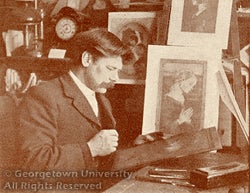Samuel Arlent Edwards was born in 1862 in Somerset, England. He studied art and architecture at the Kensington Museum Art School from 1877 to 1881, and then continued studies in engraving with Appleton, Josey & Alais in London. He achieved early success in making mezzotints of well-known paintings, a path he was to follow all his life. In 1887, he enjoyed the distinction of having an engraving exhibited at the Royal Academy in London.
In 1890 he came to the United States and established himself in New York as a book illustrator under the name S. Arlent Edwards. He then began to work on color printing from a single mezzotint plate, an art dormant since late in the eighteenth century.
"After some years of experimenting and investigating, I believe that I have succeeded in reviving the almost obsolete art of printing in color from a mezzotint plate—done in one printing and without any retouching, as was practiced a hundred years ago by the English engravers—examples of whose works are now in such great demand. I have gone far enough in my experiments to be able to confidentially announce that all the beauties of the old printing will be retained in mine, and I can secure a depth and richness of colour that can be achieved by no other system of printing."
He abhorred the traditional practice of touching up imperfect prints by hand,

Edwards' work in New York was recognized by American and European collectors. He established a well-deserved reputation for his meticulous copies of old master paintings by such artists as Botticelli, Da Vinci, Nattier, Boucher, Gainsborough, Reynolds, and Romney. He often chose a dominating detail or image as his work's focus, however, rather than reproducing the entire painting. He also occasionally modified the colors. These changes infused his work with originality and gave a vivid sense of new life to the familiar scenes.
Edwards himself inked and printed each plate for every copy, and therefore no two prints were exactly alike. He made only a limited number of copies of each work, insisting that each be sold framed, and then he destroyed each plate. His engravings were sold to subscribers by major dealers such as D. B. Butler and M. Knoedler in New York.
In 1910 he returned to Europe, living in Bruges, Belgium, continuing to issue mezzotints from there. He remained in Bruges throughout World War I despite the German occupation. When Allied troops entered Bruges at the end of the war, he acquired instant notoriety by being the first to fly the American flag. Edwards returned to the United States in 1934, settling in Westport, Connecticut. He died there in November 1938